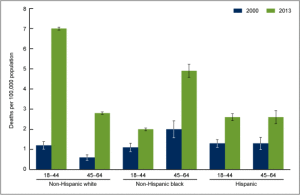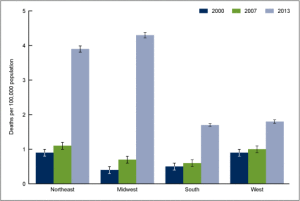We’ve all been through this. One grueling hour in a deadly silent classroom. A stack of papers before you that would decide 10% of your grade. You regurgitate as much as your punitive brain can remember, as you realize you have no idea what e0 is equal to. Once the hour is over, you file away whatever you have memorized for the past hour in some dusty corner of your mind, never to be touched again.
Test-takers and test-givers alike are realizing that the current testing system for younger children are severely lacking. A study by the Council of the Great City Schools revealed that under the Common Core, a student may take between 7 to 10 standardized tests a year. 8th graders take, on average, a startling 10.3 tests a year, and spend 25.3 hours testing. This is absolutely ridiculous.

Yet despite the amount of tests given, the education quality is not going up and US students still regularly measure poorly against similarly aged students in other countries. In response to that, the Department of Education identified the numerous amount of tests given as stress-inducing and counter productive, and set new guidelines curtailing the number of tests a student takes a year, as well as making test-taking optional in several states. All these measures aim to reduce the stress of standardized testing, promote methods of alternative testing as well as encourage students to learn, instead of memorizing and regurgitating content.

Is this really the way to solve the problem? Will reducing the stress of tests really improve the quality of education? In 2015, 20% of students opted out from taking standardized tests in New York State alone. Only 900,000 out of 1.1 million test takers took the tests. This is a significant number as in 2014, only 5% of students opted out. In fact, not a single junior in Nathan Hale High School in Seattle showed up to the state test, and definitely not because they were overly stressed. Students have started to misuse this proposed solution, undermining the usefulness of standardized testing.
Let’s look abroad. Among the countries that score better than America, Singapore’s education system is similarly rife with tests. In fact, tests are more than just a letter grade that informs you of your performance. Starting from age 8, classes are ranked by average grades, with yearly tests determining which a student would be placed into. The quality of the teachers, the attitude of your peers as well as the choices of subjects you can take is determined by which classes you get placed into. At age 12, Singaporean students take a national test that determines if they’ll be placed in a gifted school, a vocational school or a special education program and several later tests determine higher education options. 15 year olds in Singapore spend an average of 9.4 hours a week on homework (as compared to America’s 6.1). The stakes are higher and testing in Singapore is significantly more stressful in America. Yet students in Singapore score higher than America in Reading, Math and Science, topping the world in Math and Science, in particular.
On the other hand, Finland’s education system is a stark contrast. It has no standardized testing at all. Finnish students do very little homework, with a study finding that homework takes up three hours a week. Their students are not judged against each other, with the high scorers and low scorers learning in the same classroom. In fact, Finland has the lowest gap between the highest and the lowest scorers in the world. Finland’s elimination of standardized testing is partly because teachers are not held accountable for the students’ results, and therefore the country has no need for such tests to evaluate a teacher’s performance.

These two countries show that the number of tests as well as the resultant stress is independent to the quality of the education. One thing in common the two countries have is the lack of accountability the teachers face. Both Finland and Singapore hold teachers in high regard and the grades of the students are independent of the performance of the teachers. Standardized testing, extensively in Singapore and once at 16 in Finland, are held solely to measure the performance of the student.
The Common Core, America’s version of standardized testing in high schools, was started to judge how well a school was doing after, in the 90s, American students scored near the bottom in an international Math and Science test. George W Bush signed the No Child Left Behind bill and introduced standardized testing to identify and fix failing schools. Right now, the statistics gained from regular testing are used to adjust the curriculum and identify schools and students who need more help.
However, Standardized Testing also evaluates teachers, under a model called Value Added Modelling. Under this model, the funding, promotions and even the salaries of teachers are being decided by the test scores of their students. While this may help to identify bad teachers, more often than not, it penalizes our educators. When your pay and livelihood is at stake, it becomes hard not to place an emphasis on the letter grade. The teachers’ focus thus shifted from delivering knowledge to getting better letter grades. Teaching to the test, teaching only what is tested and encouraging memorization of facts over understanding concepts, started becoming a problem. Increasingly, rote memorization became the norm. Right now, even though the Common Core has increased the number of tests, there has been no significant improvement to our education as compared to the 90s. The underlying problem is the enabling and prevalence of teaching to the test. The numerous tests are merely a symptom of the problem, and America’s education system has been so wrapped up in alleviating these symptoms that they are missing the cause.
Why are we punishing our teachers if a student learns at a different pace than others? A common point in successful educational systems is that teachers are highly valued and not held accountable, allowing for more focus on imparting knowledge than raising letter grades. Standardized Testing is receiving all the flake recently but America still needs a way to measure a student’s progress, be it for improvement or higher education. To eliminate teaching to the test, we need to remove the environment that enables it. We need to eliminate the testing of our teachers. Standardized testing is definitely useful. It allows for a broad overview of how the students are doing, helps with refining curriculum and, on an individual scale, creates an urgency to review and really digest what was learnt. What we need is for teachers to be able to teach to learn instead of to memorize so that we can fully utilize the benefits of standardized testing.
UNIT IV REFLECTIONS
[1] How well does the title provocatively focus the reader’s attention, as well as the lede? Is it thoughtful, creative, clever? Does it lead the reader into the text and provide some insight into the issue?
The tile is quick and to the point. It highlights the main argument I would make later in the article in a provocative way, hopefully making readers curious about why I would say current measures only treat a symptom. The lede is humorous (hopefully), illustrating a situation many readers will connect with, making the topic more relatable to the reader.
[2] How well does the introductory section of the article invite the reader into the paper, as well as offer up exigency? How does it locate a problem or controversy within a context that provides background and rationale?
The introductory section highlights both how bad the problem has gotten (the number of tests given) as well as why, right now, this is a pertinent problem (an alarmingly high number of students boycotted the tests last year). It serves to provide a background for readers, as well as utilizes statistics to highlight exactly how bad the situation has become as this problem is one readers are probably aware of, but do not really know how exacerbated it has become.
[3] How well does the writer offer up a strong ‘idea’ that requires analysis to support and evolve it, as well as offers some point about the significance of evidence that would not have been immediately obvious to readers.?
Before introducing the concept of Accountability into the article, I preceded it by highlighting low accountability educational models in Singapore and Finland that has been successful. Only then do I delve into how accountability works in American education and how it has been misused.
[4] How well does the writer show clarity of thought; uniqueness of presentation; evidence of style; and historicized topics?
The article is linearly structured, with clear transitions between paragraphs and ideas. I think I have a clear style of writing that, with the language and tone I use, carries a knowledgeable and authoritative voice.
[5] How well does the writer recognize that a NYTs Magazine audience will challenge ideas that are overgeneralized or underdeveloped or poorly explained? (that is, did the writer avoid cliché and vagueness or address points/issues readers are likely to have?) How well did the writer decide about how to develop, sequence, and organize material?
For my Ted Talk and the NYTs article, I tried to tackle a problem that my own background afforded a different point of view to. I tried to avoid the general trends of articles on Standardized Testing and tried not to write an article that a journalist might already have written on the topic. As I was educated in Singapore, personal experience allowed me to identify Accountability as a significant difference between the two education systems. Further research revealed that while studies has been conducted, there is no big journal article linking it to the system’s current failure. I decided to highlight this overlook.
[6] How well does the writer research a controversy, develop a persuasive stance, utilize research about the topic, and join the ‘debate’ by making an argument of importance?
I took a rather controversial stand. I stood for standardized testing, whilst most stand against. By doing that, I acknowledged the failures of it, but also managed to provide ample evidence as to while it is helpful, and is not the underlying problem.
[7] How well does the writer meet or exceed research expectations of assignment requirements (6 appropriate secondary sources, 1 visual source, (or more) and primary research? ).
I used 7 articles in my essay, with the visual sources doubling as primary research as they are graphs of studies conducted.
[8] How well does the writer integrate secondary and primary sources (that support and complicate the topic) effectively into the text, introducing and contextualizing them, and “conversing” (i.e. no drop-quoting) in ways that deepen and complicate the analysis?
Sources are only introduced to substantiate a claim, or to lead into a new one. All sources introduced are meaningful, and are elaborated on in the article.
[9 How well does the writer persuade an audience to consider claims made from a particular position of authority on which you have built your research? How strong and effective is the writer’s use of rhetorical tools (ethos, logos, pathos)?
My article doesn’t argue a claim by a position of authority. The article tries to, instead, argue an alternative claim that has been overlooked, and therefore do not have a strong position of authority.
[10] How well does the writer select appropriate, interesting, revealing visual? Has the writer placed a visual strategically in the essay and provided relevant commentary on and/or analysis of them? Do the visuals contribute to the essay in meaningful ways (i.e. would the essay be affected if the writer took the visual away)?
I avoided ambiguous, illustrative imagery as it is not helpful in my topic. Instead, my images are graphs that illustrate primary research mentioned in the article, serving to help readers better visualize the severity of the three important primary sources.
[11] How well does the writer show development of final article using various drafts, in-class peer editing and workshops, and/or teacher comments?
I have always wanted to write about accountability, but through the workshops and drafts, educational models in other countries, which was initially a small part of the essay, expanded in significance. I think that was really helpful as without it, I don’t think my claim of accountability as the “big bad” in standardized testing would be as apparent.
[12] How well does the writer use hyperlinks—are they effective/appropriate?
Hyperlinks are placed every time I introduce new information and integrated into the article. This way, the article is well substantiated and gives off the impression of being knowledgeable and reliable.
[13] How well did the writer edit for grammar, style, and usage effectively? Does the writer’s attention to sentence level issues help him/her establish authority or credibility on the issue?
I tend to write in a very academic manner. Whilst I tried to shorten my sentences and lighten my tone for the article, I think my style of writing lends an authoritative voice to the article. Especially when I am raising new claim that hasn’t received much attention, the tone is important in creating a first impression.










